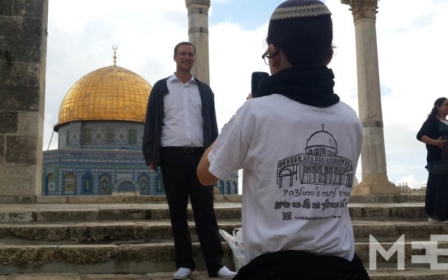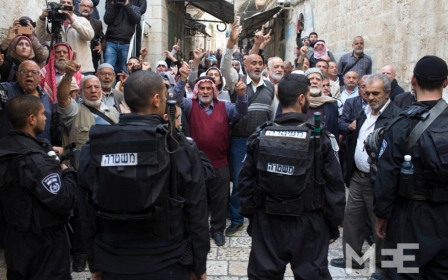'Day of Rage' in Jerusalem met with riots, Molotov cocktails and bullets

Attacks on pedestrians, mass arrests and nightly clashes with Molotov cocktails and tear gas are increasingly becoming the norm in Jerusalem. But today, the city’s security forces were braced for a particular “day of rage,” as Palestinians gathered for prayer and protest in Al-Aqsa Mosque and the troubled areas that surround the holy site.
In Shuafat, hundreds of youth clashed with Israeli forces, throwing Molotov cocktails and fireworks. Israeli troops responded with the heavy use of sponge-tipped bullets, causing at least five injuries. The refugee camp was the home of Ibrahim al-Akari, who was shot dead by police after ramming his car into crowds of pedestrians on Wednesday. Since that attack, heavy clashes have been taking place, continuously in the camp and so far have yet to dampen in intensity or scale, making it a new flashpoint in Jerusalem unrest.
Clashes were also reported in Qalandia and Issawiya, where youth attempted to remove the concrete blocks that Israeli authorities placed as roadblocks earlier this week.
The epicentre of Jerusalem’s present unrest, however, remained relatively quiet for the day. An estimated 15,000 people attended morning prayers at al-Aqsa, the holy site where recent incursions by extremist Jews have inflamed Palestinian fears and frustrations over access to the site. Today, Muslims over the age of 35 were permitted to pray at the mosque - a more lenient restriction than the usual lower age limit of forty or fifty. Heavy police presence dissuaded unrest.
“They do this to calm things down more today, to stop people from getting angrier,” Yousef, who works at a youth centre in the old city, told Middle East Eye. “There won’t be any trouble in the mosque itself, we don’t want to make problems there. The provocation comes from those who are coming in. Al-Aqsa is a holy place for Muslims, and it’s sacred - it’s not a place where we want to make problems.”
After midday prayers, large crowds of men and women flooded the old city, sipping coffee on their way home. Although the mood was calm among those returning from prayer, resentment at the heavy police presence and fear of unrest beyond the old city overshadowed the thoughts of worshippers. “We prayed in the mosque today, but our children were not allowed,” said Rana, 44, as she walked from al-Aqsa with her husband. “Because of that, we had to leave our son to pray outside. Obviously we worry that something might happen to him, but there’s nothing we can do.”
“It’s so difficult to pray at al-Aqsa,” she said. “The soldiers provoke the young people; they stare at them and wait for a reaction. Sometimes the kids do something, sometimes they don’t. You can’t know how they will react - they’re kids.”
As crowds filtered out of the old city, so did Israeli forces, leaving for the neighbourhoods where unrest was predicted later in the day. And as Palestinians continue to express their anger, a heated conflict is also brewing in Israeli society over how to deal with the escalating crisis.
This morning, at the West Jerusalem funeral of 17 year-old yeshiva student, Shalom Baadani, killed by al-Akri’s attack, Chief Rabbi, Yitzhak Yosef pleaded for Israelis to stop visiting Temple Mount, the Jewish term for the al-Aqsa complex. Doing so, he argued, is forbidden in Judaism and would lead only to further bloodshed: “We need to stop this, only then will the people of Israel's blood not be spilt," Haaretz reported him saying. "It's inconceivable that “b-rate” rabbis will argue with the Israeli’s most prominent and prestigious rabbis."
In the Hebrew language edition of Haaretz, Police Commissioner, Yohanan Danino commented that provocation at Temple Mount was the central cause of violence in Jerusalem, and reportedly urged Israeli Prime Minister Netanyahu to tone down the inflammatory comments and actions of Knesset members regarding the sacred sites.
The position is perhaps counter to emerging government policies. While the calming measure of lowering the age limit for Al Aqsa access was imposed in the old city, in other neighborhoods the response of authorities has been uncompromising. After Wednesday’s attacks Jerusalem Mayor Nir Barkat vowed to use “very, very clear aggressive force against violence”, flooding Palestinian neighborhoods and making it clear to “terrorists” that “not only will you pay with your life” but that “you will pay a very heavy price”. “There is no other way, unfortunately” Barkat said.
“They want to take the land, al-Aqsa, al-Quds. If we’re dead in the ground it doesn’t matter. They want to take everything,” Rabeah Abu Hummus, 55, from Issawiya, told MEE. She counted herself lucky to pray at al-Aqsa today, but knew she was returning home to violent clashes and an increasingly tough situation for the young people in her community. “Everyone feels they’re being hit, whether they’re young or old.”
New MEE newsletter: Jerusalem Dispatch
Sign up to get the latest insights and analysis on Israel-Palestine, alongside Turkey Unpacked and other MEE newsletters
Middle East Eye delivers independent and unrivalled coverage and analysis of the Middle East, North Africa and beyond. To learn more about republishing this content and the associated fees, please fill out this form. More about MEE can be found here.




